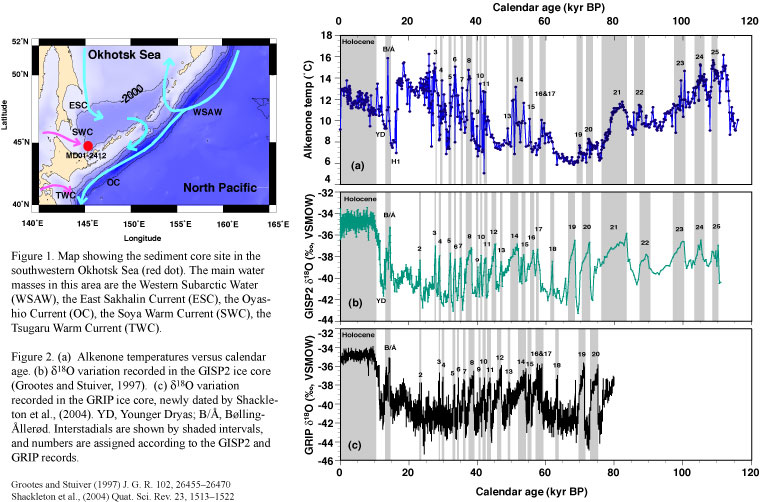|
PAGES Japan
national science highlight
Anomalously warm alkenone temperature at the interstadials recorded in the southwestern Okhotsk Sea
Naomi HARADA (Institute of Observational Research for Global Change, Japan Agency for Marine-Earth Science and Technology)
in press as “Rapid fluctuation of alkenone temperature in the southwestern Okhotsk Sea during the past 120 kyr” by Harada et al. in Global and Planetary Change

Abstract
Sea-ice expansion in the Okhotsk Sea in winter is sensitively affected by global warming and cooling. Regionally, the southwestern Okhotsk Sea is closely linked to climate change in East Asia, including Japan, because the cold sea surface temperature (SST) in the southwestern Okhotsk Sea influences directly the development of the Okhotsk atmospheric high-pressure system, and the activated Okhotsk high causes cold climatic conditions in northern Japan. Therefore, environmental change in the Okhotsk Sea indicates two-way interactions as a sensitive mirror reflecting global climate change and as a driving force of regional climate change.
To better understand how surface environmental changes in the Okhotsk Sea can influence climate change in East Asia, SSTs were estimated in the southwestern Okhotsk Sea, (Fig.1: near off “Shiretoko” which was recently registered as a new world heritage), for the past 120 kyr with millennial to centennial time resolution using the long-chain unsaturated alkyl ketone (alkenone) thermometer. The alkenone temperature, which corresponds to the SST to 20 m depth in autumn, showed repeated abrupt changes at a centennial timescale, especially during the last glacial period, 20-60 kyr before present (BP) (Fig.2). The alkenone temperature changed concurrently with changes from interstadials (warm events) to stadials (cold events) in the δ18O record of the ice cores from Greenland. Anomalously high alkenone temperatures occurred in interstadials repeatedly in the glacial period. These warm alkenone temperature episodes would have had multiple causes: (1) the main season of alkenone production may have shifted from autumn to midsummer in the glacial period because of the expansion of sea-ice coverage to nearly all seasons except midsummer, (2) related to the expansion of the sea-ice season, the sea-ice melting season may have also shifted from spring to summer, and sea-ice melting during summer might have caused super-stratification of the surface water, resulting in a high SST, and (3) an active Asian summer monsoon may have contributed to warming the surface waters of the southwestern Okhotsk Sea. These effects together could have caused anomalously high alkenone temperatures in the glacial period in the southwestern Okhotsk Sea.
|

